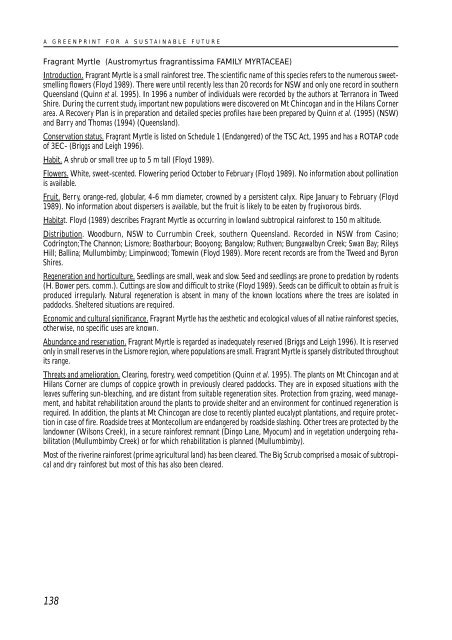Byron Flora and Fauna Study 1999 - Byron Shire Council
Byron Flora and Fauna Study 1999 - Byron Shire Council
Byron Flora and Fauna Study 1999 - Byron Shire Council
You also want an ePaper? Increase the reach of your titles
YUMPU automatically turns print PDFs into web optimized ePapers that Google loves.
A GREENPRINT FOR A SUSTAINABLE FUTURE<br />
Fragrant Myrtle (Austromyrtus fragrantissima FAMILY MYRTACEAE)<br />
Introduction. Fragrant Myrtle is a small rainforest tree. The scientific name of this species refers to the numerous sweetsmelling<br />
flowers (Floyd 1989). There were until recently less than 20 records for NSW <strong>and</strong> only one record in southern<br />
Queensl<strong>and</strong> (Quinn et al. 1995). In 1996 a number of individuals were recorded by the authors at Terranora in Tweed<br />
<strong>Shire</strong>. During the current study, important new populations were discovered on Mt Chincogan <strong>and</strong> in the Hilans Corner<br />
area. A Recovery Plan is in preparation <strong>and</strong> detailed species profiles have been prepared by Quinn et al. (1995) (NSW)<br />
<strong>and</strong> Barry <strong>and</strong> Thomas (1994) (Queensl<strong>and</strong>).<br />
Conservation status. Fragrant Myrtle is listed on Schedule 1 (Endangered) of the TSC Act, 1995 <strong>and</strong> has a ROTAP code<br />
of 3EC- (Briggs <strong>and</strong> Leigh 1996).<br />
Habit. A shrub or small tree up to 5 m tall (Floyd 1989).<br />
Flowers. White, sweet-scented. Flowering period October to February (Floyd 1989). No information about pollination<br />
is available.<br />
Fruit. Berry, orange-red, globular, 4-6 mm diameter, crowned by a persistent calyx. Ripe January to February (Floyd<br />
1989). No information about dispersers is available, but the fruit is likely to be eaten by frugivorous birds.<br />
Habitat. Floyd (1989) describes Fragrant Myrtle as occurring in lowl<strong>and</strong> subtropical rainforest to 150 m altitude.<br />
Distribution. Woodburn, NSW to Currumbin Creek, southern Queensl<strong>and</strong>. Recorded in NSW from Casino;<br />
Codrington;The Channon; Lismore; Boatharbour; Booyong; Bangalow; Ruthven; Bungawalbyn Creek; Swan Bay; Rileys<br />
Hill; Ballina; Mullumbimby; Limpinwood; Tomewin (Floyd 1989). More recent records are from the Tweed <strong>and</strong> <strong>Byron</strong><br />
<strong>Shire</strong>s.<br />
Regeneration <strong>and</strong> horticulture. Seedlings are small, weak <strong>and</strong> slow. Seed <strong>and</strong> seedlings are prone to predation by rodents<br />
(H. Bower pers. comm.). Cuttings are slow <strong>and</strong> difficult to strike (Floyd 1989). Seeds can be difficult to obtain as fruit is<br />
produced irregularly. Natural regeneration is absent in many of the known locations where the trees are isolated in<br />
paddocks. Sheltered situations are required.<br />
Economic <strong>and</strong> cultural significance. Fragrant Myrtle has the aesthetic <strong>and</strong> ecological values of all native rainforest species,<br />
otherwise, no specific uses are known.<br />
Abundance <strong>and</strong> reservation. Fragrant Myrtle is regarded as inadequately reserved (Briggs <strong>and</strong> Leigh 1996). It is reserved<br />
only in small reserves in the Lismore region, where populations are small. Fragrant Myrtle is sparsely distributed throughout<br />
its range.<br />
Threats <strong>and</strong> amelioration. Clearing, forestry, weed competition (Quinn et al. 1995). The plants on Mt Chincogan <strong>and</strong> at<br />
Hilans Corner are clumps of coppice growth in previously cleared paddocks. They are in exposed situations with the<br />
leaves suffering sun-bleaching, <strong>and</strong> are distant from suitable regeneration sites. Protection from grazing, weed management,<br />
<strong>and</strong> habitat rehabilitation around the plants to provide shelter <strong>and</strong> an environment for continued regeneration is<br />
required. In addition, the plants at Mt Chincogan are close to recently planted eucalypt plantations, <strong>and</strong> require protection<br />
in case of fire. Roadside trees at Montecollum are endangered by roadside slashing. Other trees are protected by the<br />
l<strong>and</strong>owner (Wilsons Creek), in a secure rainforest remnant (Dingo Lane, Myocum) <strong>and</strong> in vegetation undergoing rehabilitation<br />
(Mullumbimby Creek) or for which rehabilitation is planned (Mullumbimby).<br />
Most of the riverine rainforest (prime agricultural l<strong>and</strong>) has been cleared. The Big Scrub comprised a mosaic of subtropical<br />
<strong>and</strong> dry rainforest but most of this has also been cleared.<br />
138

















